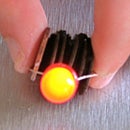Introduction: How to Make Bread (without a Bread Machine)
This is an easy, basic recipe for bread that does not require much skill.
There are many ways to make bread and this is one of them (and in my opinion, a very simple way). Remember, bread making is not an exact science.
There are many ways to make bread and this is one of them (and in my opinion, a very simple way). Remember, bread making is not an exact science.
Step 1: What You'll Need
You will need:
*Hot-ish means between 95 and 115 degrees F. much colder and it won't activate, much warmer and it will kill the little guys.
- Yeast - 2 Tbsp
- Hot-ish* water - 2 cups
- Bread flour - 5 cups total, 2 for the sponge and 3 for later. (NOT regular flour)
- Sugar - 2 Tbsp.
- Salt - 2 tsp.
- Oil - 2 Tbsp.
- 3 loaf pans
- Quick-read thermometer
- Oven pre-heated to 375
*Hot-ish means between 95 and 115 degrees F. much colder and it won't activate, much warmer and it will kill the little guys.
Step 2: Make the Sponge
This recipe uses what I call a "sponge." The sponge will activate the yeast and get things started; getting the yeast warm, happy, and ready to go
Start by mixing the hot water and the flour. Then, add 2 Tbsp. sugar, 2 Tbsp. oil, 2 Tbsp. yeast, and 2 tsp. salt.
Let this sit for about 8 or 10 minutes. Assuming your water was hot enough, it should be nice and bubbly.
Start by mixing the hot water and the flour. Then, add 2 Tbsp. sugar, 2 Tbsp. oil, 2 Tbsp. yeast, and 2 tsp. salt.
Let this sit for about 8 or 10 minutes. Assuming your water was hot enough, it should be nice and bubbly.
Step 3: Add Some Flour and Knead It
Now you need to add about 3 more cups of flour. I added a little less this time, it really depends on the humidity and how exact your measurements were in the sponge step.
Once it gets too tough to stir, flip it onto a clean floured surface. Now, knead away, adding flour as you do so.
Knead the dough for 8 or 9 minutes. As my Mother says, it should be the texture of your earlobe when it's done kneading.
When you finish this part put it back in the bowl and cover it with a slightly damp towel.
Once it gets too tough to stir, flip it onto a clean floured surface. Now, knead away, adding flour as you do so.
Knead the dough for 8 or 9 minutes. As my Mother says, it should be the texture of your earlobe when it's done kneading.
When you finish this part put it back in the bowl and cover it with a slightly damp towel.
Step 4: Let It Rise...
let the dough rise in a warm place for about 45 minutes to an hour. the dough should be about doubled in size by the time it's finished.
Step 5: Into the Pans
Punch the dough down (Yes, punch it. Beat the heck out of it. Just don't make a mess), then divide it into 3 parts. Spray the pans and put the dough in. Let it rise again in the pans (covered) until it looks like the second picture.
Step 6: Into the Oven
Preheat your oven to 375 F and put the loaves in.
Bake them for about 25 minutes. Your quick read thermometer should read between 180 and 190 degrees. Pull the loaves out and place them on their sides on a rack, after a few seconds slide them out of the pans and onto the rack. Let them cool.
Bake them for about 25 minutes. Your quick read thermometer should read between 180 and 190 degrees. Pull the loaves out and place them on their sides on a rack, after a few seconds slide them out of the pans and onto the rack. Let them cool.
Step 7: Eat!
Eat it! Share it! etc.!
You can do a lot with this recipe...
...You can add nuts, roll it out and add cinnamon and raisins for cinnamon-swirl bread, add your favorite spices, etc. Add sweet potatoes, chunks of cheese, pieces of ham, or whatever suites you. Be creative! It's your recipe to experiment with and make your own, have fun with it!
You can do a lot with this recipe...
...You can add nuts, roll it out and add cinnamon and raisins for cinnamon-swirl bread, add your favorite spices, etc. Add sweet potatoes, chunks of cheese, pieces of ham, or whatever suites you. Be creative! It's your recipe to experiment with and make your own, have fun with it!
Participated in the
The Instructables Book Contest











